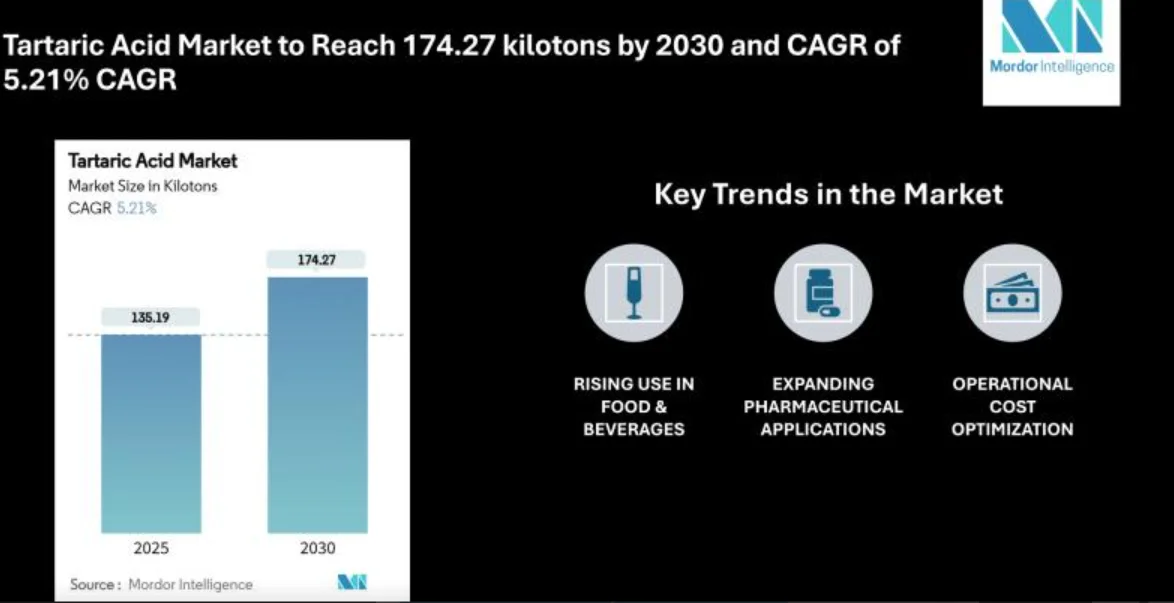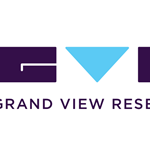Mordor Intelligence has published a new report on the "Tartaric Acid Market" offering a comprehensive analysis of size, share, trends, growth drivers, and future projections.
Introduction: Steady Growth Across Industries
The Tartaric Acid Market is projected to increase from USD 356.8 million in 2025 to USD 402.5 million by 2030, registering a CAGR of 2.45% over the forecast period (2025-2030).
Widely recognized for its role in acidity control, preservation, and antioxidant benefits, tartaric acid finds extensive applications in food processing, pharmaceuticals, and various industrial sectors. The growing popularity of packaged foods, rising wine production, and expanding use in pharmaceutical formulations are key factors driving the market's growth.
Key Trends Shaping the Tartaric Acid Market
Rising Use in Food & Beverages
Growing consumption of packaged and processed food products has boosted the demand for tartaric acid as a natural additive. Its role in acidity regulation and flavor enhancement makes it essential for bakery, confectionery, and beverage products. In the wine industry, tartaric acid helps control acidity and maintain flavor stability, supporting its significant consumption in major wine-producing regions.
Expanding Pharmaceutical Applications
The pharmaceutical industry is increasingly using tartaric acid as an excipient in tablets, syrups, and effervescent formulations. Its solubility and compatibility with active ingredients enhance drug stability, while its role in innovative drug delivery systems creates new opportunities for market growth.
Growing Personal Care and Cosmetics Demand
Tartaric acid is gaining traction in the cosmetic industry for its exfoliating properties and pH regulation. Its application in skincare formulations supports the increasing demand for premium personal care products across global markets.
Focus on Sustainable Production
With environmental sustainability gaining importance, manufacturers are adopting green extraction methods using by-products from the wine industry. This approach reduces waste and aligns with global efforts toward eco-friendly production practices.
Market Segmentation: Detailed Insights
The Tartaric Acid Market is segmented by source, application, and geography to provide a comprehensive understanding of demand patterns:
By Source
Natural Sources (Grapes, Tamarind, and Others)
Synthetic Sources
By Application
Food & Beverages (Wine, Bakery, Confectionery)
Pharmaceuticals (Tablets, Syrups, Effervescent Formulations)
Cosmetics & Personal Care
Industrial Applications (Construction, Plaster Retarders)
By Geography
North America
Europe
Asia-Pacific
Latin America
Middle East & Africa
Food & Beverages Segment Leads the Market:
The food & beverages sector holds the largest market share, supported by rising demand for flavor enhancement, shelf-life extension, and acidity regulation in beverages, confectioneries, and bakery products.
Asia-Pacific Registers Fastest Growth:
The Asia-Pacific region, led by China and India, is expected to record the fastest growth owing to rising packaged food consumption, growing pharmaceutical production, and increasing wine manufacturing.
Key Players in the Tartaric Acid Market
The tartaric acid market is competitive, with global and regional players focusing on product quality, sustainable sourcing, and strategic partnerships to strengthen their positions.
Key companies include:
Caviro Group - Known for utilizing wine by-products in tartaric acid production.
Distillerie Mazzari S.p.A. - Leading European producer catering to food and pharmaceutical sectors.
Tarcol S.A. - Specializing in high-quality tartaric acid for global markets.
PAHI S.A. - Supplying natural tartaric acid across diverse industries.
Omkar Specialty Chemicals Ltd. - Serving pharmaceutical and industrial application demands.
Strategic alliances, capacity expansions, and eco-friendly production initiatives remain central to their competitive strategies
At Mordor Intelligence, we go beyond data delivery — we decode the signals shaping global industries. Our research transforms raw numbers into strategic intelligence, uncovering the technological breakthroughs, regulatory evolutions, and market forces that define tomorrow’s business landscape.
Our in-depth analysis of the Tartaric Acid Market provides a panoramic view of innovation trajectories, strategic alliances, and competitive dynamics. This insight empowers organizations to anticipate disruption, unlock emerging opportunities, and craft resilient strategies that drive long-term growth and market leadership.
Conclusion: Positive Outlook for the Tartaric Acid Market
The Tartaric Acid Market is on track to reach USD 402.5 million by 2030, supported by rising applications across food & beverages, pharmaceuticals, cosmetics, and industrial sectors. Growing wine production, increasing demand for packaged foods, and sustainable manufacturing practices are set to drive market growth over the next five years.
For any inquiries, please contact:
media@mordorintelligence.com
https://www.mordorintelligence.com/contact-us







